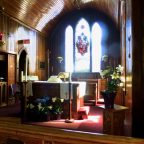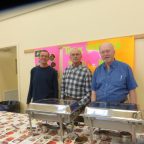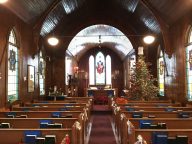An Astonishing Resurrection Faith (April 19, 2020)
This year, it seems harder to make the transition from Lent to Easter. Death seems closer than life in this time. So many people are suffering physically and psychologically and emotionally and/or financially.
Self–isolation is hard. Physical distancing is hard. To hear the news of people dying alone in seniors’ care homes, in hospitals, and at home, is hard. The staggering number of people affected by COVID–19 numbs us. These questions of death and life are hard to face.
As a result, we wonder how we can talk about resurrection when death seems to be in charge.
The truth is that we’re hardly the first people to ask these kinds of questions. Generations before us have asked the same questions. Our ancestors faced similar situations—plagues, the Spanish flu, wars, and all kinds of painful situations in which they were tempted to give up hope.
How do we speak of a faith which is based in resurrection at a time like this?
The early disciples—our ancestors in the Christian faith—asked the same question that first Easter. Today’s gospel lesson is one which returns every year.
Last week, early in the darkness of the morning, Mary was stumbling around in the garden, her vision blurred by her tears. Someone had stolen the body of her friend. She sees someone … perhaps the gardener? Then Jesus calls her name … and in that moment she recognizes him.
It was the first day of a new creation. With excitement and joy bubbling in her soul, she runs back to tell the others. A couple go running to the tomb, but they don’t understand and return to their homes.
That evening, the disciples are huddled together behind locked doors, not sure what to believe, not sure what’s happening. And Jesus simply shows up. “Peace,” he says, and the disciples begin to catch a glimpse of the joy of resurrection. They begin to sense that something new in the life of the world is happening.
But Thomas wasn’t with them. When they told him, he couldn’t believe their words. And he dares to say what many would have thought — “Unless I can see Jesus for myself, I can’t believe, I won’t believe.”
“Doubting Thomas” we call him.
And he has good reason to doubt, to ask the tough question. It is so hard to believe the possibility of resurrection. That’s not the way the world works, is it?
We are living in a time in which we are called to proclaim resurrection faith in a world which is still living with the cross.
That phrase comes from a wonderful sermon I heard last Sunday. I tried to participate in our Diocesan Easter worship last week, but I couldn’t connect. I was frustrated, and after about 10 minutes of struggling (and a little bit of cursing), I decided that that wasn’t what Easter should be.
So I gave up, and watched worship from Trinity Wall Street, a large Episcopal Church in New York City, in the epicenter of the pandemic in the USA. The preacher, Phil Jackson, began by talking about a conversation with his brother, a doctor working on the frontlines of the crisis in New York.
The preacher said, “I’m not sure I know what to say this year about the resurrection.”
There was a long pause, and then his brother replied, “It sounds to me like you have to preach resurrection faith in a world which is still living with the cross.”
Yes.
Resurrection may not be the way the world works … but we trust and proclaim that resurrection is the way God works.
As the people of God, we are called to proclaim and live out resurrection faith in a world which is still living with the cross.
One of the things I love most about this story is that Jesus shows up with a body that is still scarred and wounded and broken. He doesn’t hide the suffering, the sorrow, the brokenness. His body proclaims resurrection while showing the marks of the cross. The wounds are still so raw that the disciples can see them, can touch them.
And what this says to me is that resurrection is always proclaimed in the midst of real pain, real sorrow, real suffering.
Real life.
We call Jesus “Emmanuel”, which means “God with us.” This story is about God with us in the truest sense of that name Emmanuel. I am with you where it hurts. I am with you in the midst of your suffering. I do not float thousands of sanitized feet above your reality. I am with you through it all.
This Easter, we are called to proclaim resurrection faith in a world which is still living with the cross. It is an astonishing word, but resurrection is the way God works.
So it’s ok for us to say, as Thomas does, “I need to see signs of the life of God in this time. I’m having trouble with this right now.”
It’s ok to doubt, to ask questions, to wonder.
It’s ok to say, as the father of the boy with seizures in Mark 9, to say, “I believe; help my unbelief.”
It’s ok to want more of Jesus.
It’s ok to hold the joy of resurrection life in tension with the ache of the cross which the world is experiencing.
It’s ok to experience the joy of Easter as we live through the pain of pandemic.
Jesus comes to us bearing the wounds of the world. And Jesus says, “I understand. I understand your need to see and touch me in order to believe. Therefore, I am giving myself to you.”
But he doesn’t stop there. Jesus continues to speak a word of blessing to those of us who can no longer touch … or see … or hear. “You are blessed,” says Jesus, “if you find it within you to trust, even if you can’t see.”
Jesus doesn’t criticize. Jesus doesn’t scold. Rather, Jesus recognizes how difficult faith can be sometimes. Jesus says to us as he said to Thomas, “There’s a deeper form of trust, a deeper form of faith, that doesn’t depend on seeing. This deeper form of faith has the ability to discern my presence in all that is happening. You can discern my presence within you, among you, throughout all creation.
“I commission you to that deeper faith. I give you my Holy Spirit and send you out into the world to proclaim resurrection faith in a world which is still living with the cross. I breathe my holy spirit into you, so that you might be inspired and renewed by the gift of God’s life.”
Jesus invites us to see hope in the everyday acts of love and grace which people are performing, and to know that God is at work.
Jesus leads his people into a faith which can flourish even when everything around us is dispiriting.
Jesus opens our eyes to see God’s life, even in this time of pandemic.
Jesus tells us that faith sees beyond the surface of things, and invites us to light a single fragile, flickering candle in the darkness, to sing a song of hope in the valley of the shadow of death.
Yes, it’s an astonishing invitation, to see beyond death to life, to proclaim resurrection faith in a world living with the cross. But as the theologian Karl Barth reminded us, the resurrection is meant to astonish us. Resurrection is not an ordinary event. It calls us to question our assumptions, to look deeper into life, and to see God where we never expected God to be.
We see life in the grave.
We proclaim resurrection faith in a world which is still living with the cross.
That’s the Easter trust to which Jesus calls us. 1 Peter 2 echoes Jesus’ invitation, “We are a chosen race, a royal priesthood, a holy nation, God’s own people, in order that we may proclaim the mighty acts of him who called us out of darkness into his marvellous light.”
Thanks be to God.
Rev. Dr. Yme Woensdregt
April 19, 2020 (2nd Sunday of Easter)
John 20: 19–31
Acts 2: 22–32
1 Peter 2: 2–10







